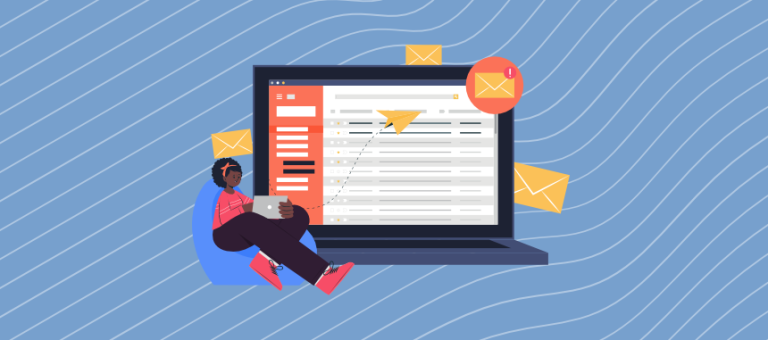What is email scrubbing?
Email scrubbing is the process of removing subscribers that are impacting your campaign performance and sender score with ISPs.
Here are some examples of contacts you should remove when scrubbing emails:
- Unused email addresses
- Inactive respondents (with low open and click-through rates)
- Duplicate emails
- Those who report your emails as spam
- Email addresses that cause bounces
Why email scrubbing is important
ISPs monitor your campaign stats and the number of bounces, blocks and spam reports to determine your sender score. If you have critically low rates of engagement and high bounce rates, you’re likely to receive a lower sender score.
The absolute worst thing that could happen is your email domain is blocked. By scrubbing your email list, you will:
- Receive fewer spam complaints and avoid your emails being sent to the spam folder
- Increase open rates and click-through rates
- Improve email deliverability
- Increase sender reputation (score)
- Save money per campaign and increase ROI
Maintaining a clean email list will allow you to continue producing email marketing campaigns that your audience engages with.
How often should you scrub email lists?
This is entirely dependent on your industry and the frequency of your email campaigns. If you’re a seasonal business, it’s probably not a good idea to clean your lists more than once a year. You’ll want to see what your engagement rates are like at your peak times and use that data to determine whether you should scrub email addresses.
But if your campaigns are more consistent, say two or three times a week, you’ll have a lot more data to benchmark on. You should consider cleaning your list at least once a year, but the higher number of emails you send the more of a foundation you have to make a decision.
Thing to consider before email scrubbing
Before cleaning your list, you’ll want to determine if there are any other reasons why your emails might be performing poorly.
Bounces
Before cleaning your list, you’ll want to determine if there are any other reasons why your emails might be performing poorly.
For example, is there a technical reason your emails are bouncing? Is there a way you can remedy that without losing valuable contacts?
Email clients
Or, are all your inactive users using the same email client, e.g. Gmail? This may be a sign that this particular client is diverting all your emails to spam or junk folders. You may have to query with the support team of an individual email client to resolve issues like this.
List building and consent
Or, are all your inactive users using the same email client, e.g. Gmail? This may be a sign that this particular client is diverting all your emails to spam or junk folders.
It’s also important to consider how you collected the email addresses and how they’re segmented into lists/ groups. Have you given contacts an option to change what email lists they’re subscribed to? Maybe they only want to receive emails related to products and services as opposed to marketing content.
More importantly, did you collect consent to send emails with a double opt-in? If you haven’t collected consent from contacts there’s a higher chance you’ll end up sending emails to a spam trap. These addresses look the same as all others but are sued by ISPs to identify senders who aren’t maintaining a healthy list.
Inactive customers
You should also be cautious when removing paying customers from email lists. The best course of action here would be to group customers into an ‘inactive customers’ list and break them down into product life cycles. If you have customers subscribed to an annual plan, they might not feel it’s warranted to read your emails.
It’s up to you to decide whether you continue to send emails to these customers, but why not consider a more personalized approach, where an automated email with new features or plans is sent towards the end of their current subscription.
How to clean email lists (email scrubbing)
Once you’ve explored all the avenues above, it’s time to start email scrubbing. We’ve broken this process down into six easy steps:
- Identify inactive subscribers
- Segment the inactive subscribers
- Attempt to re-engage those contacts
- Clean the segment
- Remove duplicates, spam and bounced contacts
- Re-engage your clean email list
1. Identify inactive subscribers
What is an inactive subscriber? These are contacts who haven’t engaged with your emails over a set period of time. This period of time is determined by you and should be based on how frequently you send emails.
For example, if you only send emails once a month, inactive subscribers could be defined as those who haven’t opened an email in six months. But if you send multiple emails a week, you can reduce the defining period of time to three weeks.
Of course, there are those who’ve never engaged with your emails. These may be people who’ve signed up with a secondary email address or even bots that have subscribed to your list. You can easily identify these contacts and remove them from your email list.
2. Segment the inactive subscribers
The simplest way to do this is from inside your email marketing tool.
With Shout, go to “Contacts”, select “Segment” and create a new segment. Enter the criteria you’ve set to define inactive subscribers and then give your new segment a name, like “Inactive Subscribers”.
3. Attempt to re-engage those contacts
If you can save some of the contacts you’ve worked so hard to collect, now’s the time to do it. Think of something enticing to get your subscribers to re-engage with you. For example:
- An exceptional piece of content
- A discount on their next purchase
- A competition or prize draw
- Early access to a new feature or product
Ask yourself why they signed up in the first place, there had to be some reason. Very few people will subscribe to your email list out of the good of their hearts. The problem may be your campaigns have veered too far from what contacts originally wanted or needed.
Or maybe that isn’t the problem, maybe you already solved their problems and that’s why they don’t feel the need to read your emails anymore.
Here’s your chance to make a survey and ask your subscribers why they don’t read your emails and what you can do to spark that interest again.
4. Clean the segment
Think of an amount of time you’re happy to wait and see if your subscribers re-engage, maybe that’s a week, maybe it’s a month, it’s up to you.
If they haven’t opened your email in that time, it’s probably time to remove inactive contacts from your email list. If they’ve opened the email, but haven’t clicked any links you need to decide how valuable those contacts are to you. We’d recommend keeping them and continuing to deliver top quality content, you might just have to find the right fit for them.
To scrub your email list with Shout, all you’ll need to do is select the segment then choose “Unsubscribe” from the dropdown.
You might want to export the list beforehand and keep the inactive subscribers on file, again this is your call.
5. Remove duplicates, spam and bounced contacts
You also need to remember to remove any email addresses that cause bounces (especially hard bounces), report your campaigns as spam (which can have a negative impact on your sender score) and any duplicates that you may have on your list.
If you’ve uploaded contacts to Shout, we’ll automatically flag any duplicates as the list is being uploaded. And even if they subscribe multiple times using an [online form], you won’t be charged for duplicates and we won’t send multiple emails to them.
To identify any subscribers that fit the above criteria, you can navigate to “Contacts” and filter by bounces, spam reports or duplicates to find them. You can then use a bulk action to unsubscribe them for a clean email list.
You could also consider using an email validation tool (email list cleaning service) such as Zerobounce, which provides a bulk email verifier. Essentially, you can upload your mailing list and their tool verifies email addresses for you.
6. Re-engage your clean email list
Now you’ve finished your email scrubbing, it’s time to set a benchmark performance. Create a campaign and send it to your newly scrubbed email list, wait the usual amount of time you would before analyzing performance and then take note.
You can compare this to your last performance review (before you cleaned up your email list) to visualize the effectiveness of email scrubbing, but more importantly, you’ll want to use these email metrics as your new benchmark.
Keeping your list clean after email scrubbing
Once you’ve cleaned your email list, you have to strive to maintain that standard. When collecting new subscribers, ensure to use a double opt-in process and send email campaigns that are relevant and useful.
This should be at the forefront of your mind from the very first email you send to contacts. Take a look at how to create a welcome email that engages subscribers and keeps them coming back for future emails. Then, once you’ve learned more about them, move onto creating drip email marketing campaigns that deliver valuable and personalized content.
Another way you can maintain list health is by allowing contacts to manage their own email settings. So, create a form they can use to change list preferences. If you don’t do this, their only option will be to unsubscribe, which means you lose them altogether.
Hopefully, we’ve given you everything you need to clean up your email list and improve the performance of your campaigns. If you’d like more tips, head over to our complete email marketing guide.




